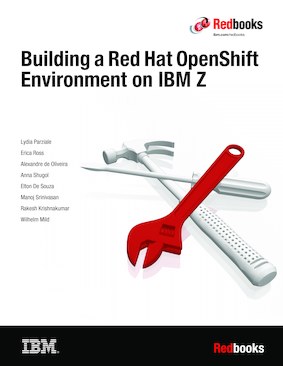Building a Red Hat OpenShift Environment on IBM Z
An IBM Redbooks publication
Published 10 August 2022

ISBN-10: 0738460745
ISBN-13: 9780738460741
IBM Form #: SG24-8515-00
(134 pages)
View online
Authors: Lydia Parziale, Alexandre de Oliveira, Anna Shugol, Elton de Souza, Wilhelm Mild, Rakesh Krishnakumar, Manoy Srinivasan
Abstract
Cybersecurity is the most important arm of defense against cyberattacks. With the recent increase in cyberattacks, corporations must focus on how they are combating these new high-tech threats.
When establishing best practices, a corporation must focus on employees’ access to specific workspaces and information. IBM Z® focuses on allowing high processing virtual environments while maintaining a high level of security in each workspace.
Organizations not only need to adjust their approach to security, but also their approach to IT environments. To meet new customer needs and expectations, organizations must take a more agile approach to their business.
IBM® Z allows companies to work with hybrid and multi-cloud environments that allows more ease of use for the user and efficiency overall. Working with IBM Z, organizations can also work with many databases that are included in IBM Cloud Pak® for Data. IBM Cloud Pak for Data allows organizations to make more informed decisions with improved data usage.
Along with the improved data usage, organizations can see the effects from working in a Red Hat OpenShift environment. Red Hat OpenShift is compatible across many hardware services and allows the user to run applications in the most efficient manner.
The purpose of this IBM Redbooks® publication is to:
- Introduce IBM Z and LinuxONE platforms and how they work with the Red Hat OpenShift environment and IBMCloud Pak for Data
- Provide examples and the uses of IBM Z with Cloud Paks for Data that show data gravity, consistent development experience, and consolidation and business resiliency
The target audience for this book is IBM Z Technical Specialists, IT Architects, and System Administrators.
Table of contents
Chapter 1. Hybrid cloud overview and introduction to containers and microservices concepts
Chapter 2. Architectural overview
Chapter 3. Red Hat OpenShift Container Platform installation for KVM on LinuxONE
Chapter 4. Use Case: Cloud Pak for Data platform that is running containerized Db2 service
Chapter 5. Use Case: A Red Hat OpenShift environment that is colocated with z/OS transactional services and DB2 data
Appendix A. Installing Red Hat OpenShift Container Storage on IBM Z
